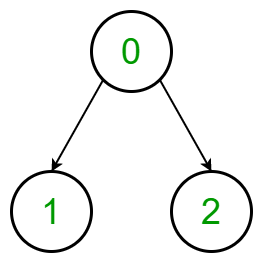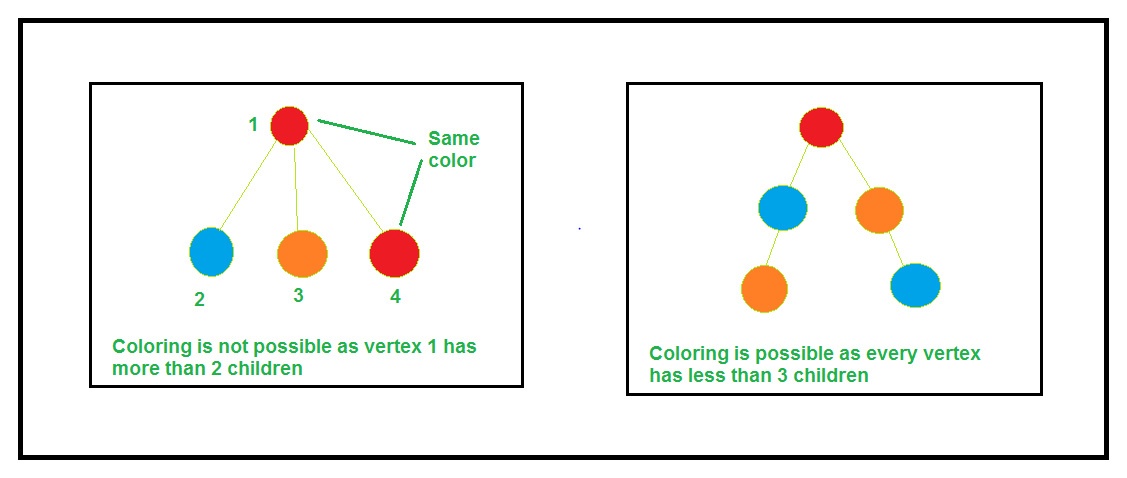给定一棵树,其N 个节点的值从0到(N – 1)和一个大小为3xN的二维数组arr[][] ,其中arr[i][j]表示用颜色值i为第 j 个节点着色的成本。任务是找到给给定树的节点着色的最小成本,使得每条长度为 3 的路径都用不同的颜色着色。如果有任何可能的方法为树的节点着色,则打印成本,否则打印“不可能” 。
例子:
Input: arr[][] = {{3, 2, 3}, {4, 3, 2}, {3, 1, 3}},
Tree:

Output: 6
Explanation:
Color the vertex 0 with type 1 color, cost = 3
Color the vertex 1 with type 3 color, cost = 1
Color the vertex 2 with type 2 color, cost = 2
Therefore the minimum cost is 3 + 1 + 2 = 6
Input: arr[][] = {{3, 4, 2, 1, 2}, {4, 2, 1, 5, 4}, {5, 3, 2, 1, 1}},
Tree:

Output: NOT POSSIBLE
方法:这个想法是进行观察。我们需要观察,如果有一个顶点有两条以上的边,答案是不可能的。答案只存在于链式结构,即,

- 最初,我们检查对于任何节点是否存在两个以上的子节点。
- 如果存在,那么答案是不可能的。
- 如果不存在,则只有3 P 2可用排列。因此,只需检查所有六种可能的排列并找到最低成本。
下面是上述方法的实现:
C++
// C++ program to find the
// minimum possible cost
// to colour a given tree
#include
using namespace std;
// Class to define a tree
class tree {
vector > g;
vector chain;
int minimum;
public:
// Constructor
tree(int n)
{
g = vector >(n);
minimum = 1e6;
}
// Function for pushing edges
void addEdge(int u, int v)
{
g[v].push_back(u);
g[u].push_back(v);
}
// Dfs function to make the chain
// structure of tree in a vector
void dfs(int v, int p = -1)
{
chain.push_back(v);
for (auto i : g[v]) {
if (i == p)
continue;
dfs(i, v);
}
}
// Function that checks all the
// six different type of
// coloring and find the
// minimum of them
void check(int n, int a, int b,
vector > cost)
{
int sum = 0;
vector res(n);
// Assign the color type 1
// to the first element
res[0] = a;
// Assign the color type 2
// to the second element
res[1] = b;
// Add the cost of the color
// of the first element
sum += cost[a][chain[0]];
// Add the cost of the color
// of the second element
sum += cost[b][chain[1]];
for (int i = 2; i < n; i++) {
// Assign the next element in chain
// with different color
res[i] = 3 - res[i - 1] - res[i - 2];
// Add the cost of the element color
sum += cost[res[i]][chain[i]];
}
// Finding the minimum from all cases
if (sum < minimum)
minimum = sum;
}
// Function to find the
// minimum possible cost
// to colour a given tree
void minimumCost(int n,
vector > cost)
{
for (int i = 0; i < n; i++) {
// Condition to check if
// any vertex consists more than
// 2 edges, then the coloring of
// the vertices is not possible
if (g[i].size() > 2) {
cout << "NOT POSSIBLE"
<< "\n";
return;
}
}
int start;
// Find the starting/ending vertex
for (int i = 0; i < n; i++) {
if (g[i].size() == 1)
start = i;
}
// Call dfs function staring from
// the start vertex
dfs(start);
// Check for all six different
// possible cases
check(n, 0, 1, cost);
check(n, 0, 2, cost);
check(n, 1, 0, cost);
check(n, 1, 2, cost);
check(n, 2, 0, cost);
check(n, 2, 1, cost);
// Printing the minimum cost
cout << minimum << "\n";
}
};
// Driver code
int main()
{
tree t(5);
t.addEdge(0, 1);
t.addEdge(1, 2);
t.addEdge(2, 3);
t.addEdge(3, 4);
vector > arr
= { { 3, 4, 2, 1, 2 },
{ 4, 2, 1, 5, 4 },
{ 5, 3, 2, 1, 1 } };
t.minimumCost(5, arr);
return 0;
} Python3
# Python3 program to find the
# minimum possible cost
# to colour a given tree
# Class to define a tree
class tree:
def __init__(self, n):
self.g = [[] for i in range(n)]
self.minimum = 1000000
self.chain = []
# Function for pushing edges
def addEdge(self, u, v):
self.g[v].append(u);
self.g[u].append(v);
# Dfs function to make the chain
# structure of tree in a vector
def dfs(self, v, p = -1):
self.chain.append(v);
for i in self.g[v]:
if (i == p):
continue;
self.dfs(i, v);
# Function that checks all the
# six different type of
# coloring and find the
# minimum of them
def check(self, n, a, b, cost):
sum = 0;
res=[0 for i in range(n)]
# Assign the color type 1
# to the first element
res[0] = a;
# Assign the color type 2
# to the second element
res[1] = b;
# Add the cost of the color
# of the first element
sum += cost[a][self.chain[0]];
# Add the cost of the color
# of the second element
sum += cost[b][self.chain[1]];
for i in range(2, n):
# Assign the next element in chain
# with different color
res[i] = 3 - res[i - 1] - res[i - 2];
# Add the cost of the element color
sum += cost[res[i]][self.chain[i]];
# Finding the minimum from all cases
if (sum < self.minimum):
self.minimum = sum;
# Function to find the
# minimum possible cost
# to colour a given tree
def minimumCost(self, n, cost):
for i in range(n):
# Condition to check if
# any vertex consists more than
# 2 edges, then the coloring of
# the vertices is not possible
if (len(self.g[i]) > 2):
print("NOT POSSIBLE")
return;
start = 0
# Find the starting/ending vertex
for i in range(n):
if (len(self.g[i]) == 1):
start = i;
# Call dfs function staring from
# the start vertex
self.dfs(start);
# Check for all six different
# possible cases
self.check(n, 0, 1, cost);
self.check(n, 0, 2, cost);
self.check(n, 1, 0, cost);
self.check(n, 1, 2, cost);
self.check(n, 2, 0, cost);
self.check(n, 2, 1, cost);
# Printing the minimum cost
print(self.minimum)
# Driver code
if __name__=='__main__':
t=tree(5);
t.addEdge(0, 1);
t.addEdge(1, 2);
t.addEdge(2, 3);
t.addEdge(3, 4);
arr = [[ 3, 4, 2, 1, 2 ],
[ 4, 2, 1, 5, 4 ],
[ 5, 3, 2, 1, 1 ]];
t.minimumCost(5, arr);
# This code is contributed by rutvik_56C#
// C# program to find the
// minimum possible cost
// to colour a given tree
using System;
using System.Collections;
using System.Collections.Generic;
// Class to define a tree
class tree{
public ArrayList g;
public ArrayList chain;
public int minimum;
// Constructor
tree(int n)
{
g = new ArrayList();
chain = new ArrayList();
for(int i = 0; i < n; i++)
{
g.Add(new ArrayList());
}
minimum = 1000000;
}
// Function for pushing edges
void addEdge(int u, int v)
{
((ArrayList)g[v]).Add(u);
((ArrayList)g[u]).Add(v);
}
// Dfs function to make the chain
// structure of tree in a vector
void dfs(int v, int p = -1)
{
chain.Add(v);
foreach(int i in (ArrayList)g[v])
{
if (i == p)
continue;
dfs(i, v);
}
}
// Function that checks all the
// six different type of
// coloring and find the
// minimum of them
void check(int n, int a, int b,
ArrayList cost)
{
int sum = 0;
ArrayList res = new ArrayList();
for(int i = 0; i < n; i++)
{
res.Add(0);
}
// Assign the color type 1
// to the first element
res[0] = a;
// Assign the color type 2
// to the second element
res[1] = b;
// Add the cost of the color
// of the first element
sum += (int)((ArrayList)cost[a])[(int)chain[0]];
// Add the cost of the color
// of the second element
sum += (int)((ArrayList)cost[b])[(int)chain[1]];
for(int i = 2; i < n; i++)
{
// Assign the next element in chain
// with different color
res[i] = 3 - (int)res[i - 1] - (int)res[i - 2];
// Add the cost of the element color
sum += (int)((ArrayList)cost[(
int)res[i]])[(int)chain[i]];
}
// Finding the minimum from all cases
if (sum < minimum)
minimum = sum;
}
// Function to find the
// minimum possible cost
// to colour a given tree
void minimumCost(int n,
ArrayList cost)
{
for(int i = 0; i < n; i++)
{
// Condition to check if
// any vertex consists more than
// 2 edges, then the coloring of
// the vertices is not possible
if (((ArrayList)g[i]).Count > 2)
{
Console.WriteLine("NOT POSSIBLE");
return;
}
}
int start = 0;
// Find the starting/ending vertex
for(int i = 0; i < n; i++)
{
if (((ArrayList)g[i]).Count == 1)
start = i;
}
// Call dfs function staring from
// the start vertex
dfs(start);
// Check for all six different
// possible cases
check(n, 0, 1, cost);
check(n, 0, 2, cost);
check(n, 1, 0, cost);
check(n, 1, 2, cost);
check(n, 2, 0, cost);
check(n, 2, 1, cost);
// Printing the minimum cost
Console.WriteLine(minimum);
}
// Driver code
public static void Main(string []args)
{
tree t = new tree(5);
t.addEdge(0, 1);
t.addEdge(1, 2);
t.addEdge(2, 3);
t.addEdge(3, 4);
ArrayList arr = new ArrayList();
arr.Add(new ArrayList(){ 3, 4, 2, 1, 2 });
arr.Add(new ArrayList(){ 4, 2, 1, 5, 4 });
arr.Add(new ArrayList(){ 5, 3, 2, 1, 1 });
t.minimumCost(5, arr);
}
}
// This code is contributed by pratham76输出:
9时间复杂度: O(N) ,其中 N 是树中的节点数。
如果您想与行业专家一起参加直播课程,请参阅Geeks Classes Live